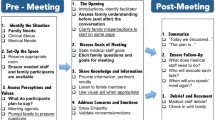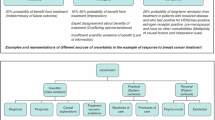Abstract
Objective
Explore NICU parents’ perspectives on how statistics are used to communicate prognostic uncertainty.
Study design
A secondary qualitative grounded theory analysis of semi-structured interviews with parents of current and past NICU patients focusing on their experience with prognostic uncertainty.
Results
Parents had varying opinions on the use of statistics. These views depended on many factors, including the motives for sharing statistics, their child’s clinical status, their own emotional state, and their relationship with the provider communicating the uncertainty. Depending upon how statistics were utilized, parents felt they could be helpful and desired at times, but also harmful and counterproductive at others. Parents also shared recommendations on how statistics should be utilized in communicating uncertainty.
Conclusion
This study reveals an important parental perspective on communication for anyone caring for critically ill neonates. In sharing recommendations for communicating uncertainty with statistics, this study can help providers enhance relationships with parents.
This is a preview of subscription content, access via your institution
Access options
Subscribe to this journal
Receive 12 print issues and online access
$259.00 per year
only $21.58 per issue
Buy this article
- Purchase on SpringerLink
- Instant access to full article PDF
Prices may be subject to local taxes which are calculated during checkout

Similar content being viewed by others
References
Malin KJ, Johnson TS, Brown RL, Leuthner J, Malnory M, White-Traut R, et al. Uncertainty and perinatal post-traumatic stress disorder in the neonatal intensive care unit. Res Nurs Health. 2022;45:717–32. Dec.
Rambod M, Pasyar N, Mazarei Z, Soltanian M. The predictive roles of parental stress and intolerance of uncertainty on psychological well-being of parents with a newborn in neonatal intensive care unit: a hierarchical linear regression analysis. BMC Pediatr. 2023;23:607 Dec 1.
Krawczyk M, Gallagher R. Communicating prognostic uncertainty in potential end-of-life contexts: experiences of family members. BMC Palliat Care. 2016;15:59. Jul 12.
Evans LR, Boyd EA, Malvar G, Apatira L, Luce JM, Lo B, et al. Surrogate decision-makers’ perspectives on discussing prognosis in the face of uncertainty. Am J Respir Crit Care Med. 2009;179:48–53. Jan 1.
Zier LS, Burack JH, Micco G, Chipman AK, Frank JA, Luce JM, et al. Doubt and belief in physicians’ ability to prognosticate during critical illness: the perspective of surrogate decision makers. Crit Care Med. 2008;36:2341–7. Aug.
Martin EJ, Widera E. Prognostication in serious illness. Med Clin North Am. 2020;104:391–403. May.
Woloshin S, Schwartz LM, Welch HG. Patients and medical statistics. Interest, confidence, and ability. J Gen Intern Med. 2005;20:996–1000. Nov.
Schapira MM, Fletcher KE, Gilligan MA, King TK, Laud PW, Matthews BA, et al. A framework for health numeracy: how patients use quantitative skills in health care. J Health Commun. 2008;13:501–17. Jul 23.
Krick JA, Weiss EM, Snyder A, Haldar S, Campelia GD, Opel DJ. Living with the unknown: a qualitative study of parental experience of prognostic uncertainty in the neonatal intensive care unit. Am J Perinatol. 2021;38:821–7. Jul.
Charmaz K. Constructing grounded theory: a practical guide through qualitative analysis. Los Angeles: Sage; 2012. p. 208.
Brashers DE. Communication and uncertainty management. J Commun. 2001;51:477–97. Sep 1.
Brouwer MA, Maeckelberghe ELM, van der Heide A, Hein IM, Verhagen EAAE. Breaking bad news: what parents would like you to know. Arch Dis Child. 2021;106:276–81. Mar.
Prins S, Linn AJ, van Kaam AHLC, van de Loo M, van Woensel JBM, van Heerde M, et al. How physicians discuss uncertainty with parents in intensive care units. Pediatrics. 2022;149:e2021055980. Jun 1.
Gorsky KG, Butala S, House M, Moon C, Calvetti S, Khando T, et al. Uncertainty and the NICU experience: a qualitative evaluation of family and provider perspectives. Child. 2023;10:1745 Oct 27.
Lemmon ME, Huffstetler H, Barks MC, Kirby C, Katz M, Ubel PA, et al. Neurologic outcome after prematurity: perspectives of parents and clinicians. Pediatrics. 2019;144:e20183819. Jul.
Lusardi A. Numeracy, financial literacy, and financial decision-making [Internet]. Cambridge, MA: National Bureau of Economic Research; 2012 Feb [cited 2025 Apr 24] p. w17821. Report No.: w17821. Available from: http://www.nber.org/papers/w17821.pdf
Spiegelhalter D, Pearson M, Short I. Visualizing uncertainty about the future. Science. 2011;333:1393–400. Sep 9.
OECD. Do adults have the skills they need to thrive in a changing world?: Survey of adult skills 2023 [Internet]. OECD; 2024 [cited 2025 Apr 24]. (OECD Skills Studies). Available from: https://www.oecd.org/en/publications/do-adults-have-the-skills-they-need-to-thrive-in-a-changing-world_b263dc5d-en.html
Reyna VF, Nelson WL, Han PK, Dieckmann NF. How numeracy influences risk comprehension and medical decision making. Psychol Bull. 2009;135:943–73.
Sullivan A, Cummings C. Historical perspectives: shared decision making in the NICU. NeoReviews. 2020;21:e217–25. Apr.
Forth FA, Hammerle F, König J, Urschitz MS, Neuweiler P, Mildenberger E, et al. Optimistic vs pessimistic message framing in communicating prognosis to parents of very preterm infants: the COPE randomized clinical trial. JAMA Netw Open. 2024;7:e240105 Feb 5.
Haward MF, Murphy RO, Lorenz JM. Message framing and perinatal decisions. Pediatrics. 2008;122:109–18. Jul.
Nayak B, Moon JY, Kim M, Fischhoff B, Haward MF. Optimism bias in understanding neonatal prognoses. J Perinatol J Calif Perinat Assoc. 2021;41:445–52. Mar.
Krick JA, Feltman DM, Arnolds M. Decision-making for extremely preterm infants: a qualitative systematic review. J Pediatr. 2022;251:6–16. Dec.
French KB. Care of extremely small premature infants in the neonatal intensive care unit. A Parent’s Perspect Clin Perinatol. 2017;44:275–82. Jun.
Schwarze ML, Taylor LJ. Managing uncertainty—harnessing the power of scenario planning. N Engl J Med. 2017;377:206–8. Jul 20.
Boss RD, Hutton N, Sulpar LJ, West AM, Donohue PK. Values parents apply to decision-making regarding delivery room resuscitation for high-risk newborns. Pediatrics. 2008;122:583–9. Sep.
Grinberg GR. When practice questions become real life. JAMA. 2022;328:711 Aug 23.
Kratovil AL, Julion WA. Health-care provider communication with expectant parents during a prenatal diagnosis: an integrative review. J Perinatol J Calif Perinat Assoc. 2017;37:2–12. Jan.
Webbe J, Brunton G, Ali S, Longford N, Modi N, Gale C, et al. Parent, patient and clinician perceptions of outcomes during and following neonatal care: a systematic review of qualitative research. BMJ Paediatr Open. 2018;2:e000343.
Krick JA, Rholl EL, Callahan KP, Harris KW, Weiss EM. Uncertainties in the NICU: a scoping review to inform a tailored taxonomy. J Perinatol. 2025;45:713–25.
Kaemingk BD, Carroll K, Thorvilson MJ, Schaepe KS, Collura CA. Uncertainty at the limits of viability: a qualitative study of antenatal consultations. Pediatrics. 2021;147:e20201865. Apr.
Drach LL, Hansen DA, King TM, Sibinga EMS. Communication between neonatologists and parents when prognosis is uncertain. J Perinatol. 2020;40:1412–22. Sep.
Sanders MR, Hall SL. Trauma-informed care in the newborn intensive care unit: promoting safety, security and connectedness. J Perinatol. 2018;38:3–10. Jan.
Bonnot Fazio S, Dany L, Dahan S, Tosello B. Communication, information, and the parent-caregiver relationship in neonatal intensive care units: a review of the literature. Arch Pediatr. 2022;29:331–9. Jul.
Mercurio MR. Priorities, professional humility, and communication in the setting of medical uncertainty. Pediatrics. 2022;149:e2022056737. Jun 1.
Perlis RH, Ognyanova K, Uslu A, Lunz Trujillo K, Santillana M, Druckman JN, et al. Trust in physicians and hospitals during the COVID-19 pandemic in a 50-state survey of US adults. JAMA Netw Open. 2024;7:e2424984 Jul 1.
Author information
Authors and Affiliations
Contributions
JK was responsible for the design of the study, the coding and analysis of the data, the drafting of the manuscript, and created the final manuscript. CT and NZ participated in initial coding and thematic analysis. They reviewed, edited and approved the final manuscript. MA participated in initial coding, thematic analysis, and further theory development. She reviewed, edited and approved the final manuscript.
Corresponding author
Ethics declarations
Competing interests
The authors declare no competing interests.
Ethics approval and consent to participate
The original study was approved by the Seattle Children’s Hospital Institutional Review Board as exempt and was performed in accordance with the Declaration of Helsinki. The need for informed consent was waived.
Additional information
Publisher’s note Springer Nature remains neutral with regard to jurisdictional claims in published maps and institutional affiliations.
Rights and permissions
About this article
Cite this article
Krick, J.A., Toffler, C.E., Zhou, N.Y. et al. Parents’ perspectives on the use of statistics to convey uncertainty in the NICU: a qualitative analysis. J Perinatol (2025). https://doi.org/10.1038/s41372-025-02439-2
Received:
Revised:
Accepted:
Published:
DOI: https://doi.org/10.1038/s41372-025-02439-2



